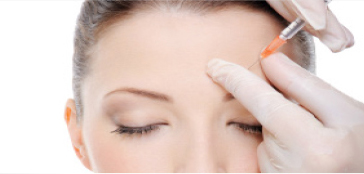Temporary and Permanent Filling Materials
Temporary and Permanent Filling MaterialsFilling materials are used to fill wrinkles, fine lines, depressions and to add volume. They can also be used to design, sculpt and restore other areas of the face and to correct asymmetries. In some cases they are used to fill and fade scars and pits.
One of the secrets of the filling technique is the injection of the material not only directly into the wrinkle, but also around it and several depths underneath, in order to produce a wider foundation for the flattening, smoothing and filling of the depression or wrinkle. Sometimes a crisscross injection technique is used.
Generally, a filling material must satisfy several criteria:
- Tissue ‘friendly’ (biocompatible).
- Make the skin look as natural as possible.
- Effectively fill wrinkles and furrows.
- Cause minimum side effects and/or allergies.
- Provide a long lasting effect.
- Fixation - stay where it is injected.
- Cost effective - give maximum value for price.
- Choose the right material in motorial and fast absorbing areas, such as the lips.
Temporary filling materials:
Just as their name implies, their effect lasts between several months and 2.5 years, depending on the type, quality and quantity of the injected material (higher volume will last longer).
Natural materials:
Collagen
Collagen is extracted from the connecting tissue of cattle and processed so it can be injected into humans. It has been in use since the end of the 1970's. it was the first filling material for wrinkles.
Main disadvantages: it is an allergen (causes allergies) and highly absorbent. For this reasons, it is not much in use now.
Durability: 2 - 6 months.
Side effects: infections, hemorrhage, redness, swelling, hypersensitivity, allergy.
Autologous Fat
The fat is extracted from body areas with excessive fat, such as the hips, buttocks and the hypogastrium (the lower part of the abdomen).
Main disadvantage -“ it is relatively highly absorbent and in some cases not uniformly absorbed, so there may be small lumps of fat in the injected area.
Side effects: infections, swelling, small lumps of fat which cause non-uniform look.
Cosmoderm - human collagen
Cosmoderm is a collagen extracted from humans, and therefore not an allergen.
Durability: 2 - 6 months
Side effects: infections, hemorrhages, redness and local swelling
Evolence
Evolence is a new type of collagen which is not an allergen. It is based on "Glymatrix" technology that binds sugar and protein, imitating the natural collagen production process in the body. It is more suitable for expression wrinkles and less for lips filling, where it lasts a shorter time.
Durability: approximately 1 year.
Side effects: redness, hemorrhage, swelling.
Artecoll
Artecoll is composed of microscopic polymethyl methacrylate beads (30%) in a collagen solution (70%).
Disadvantages - it is an allergen like collagen. It can cause granulomas - small bumps under the skin.
Side effects: hypersensitivity, infection and granulomas in the injected area.
Semi natural materials
This category includes all the materials that contain Hyaluronic Acid, which is a polysaccharide product found naturally in our body's connective tissues, and is capable of attracting and binding water (hygroscopic). Water constitutes a large portion of the injected material. (Restylane, Restylane Perlane, Teosyal, Juvederm, Reviderm and many others).
Poly-L-lactic Acid
A synthetic material based on lactic acid that is found naturally in the human body. (Newfill) – Rarely in use today.
Radiesse
A material made of calcium hydroxyl-apatite, a mineral that is a natural constituent of bones in our body. It is a synthetic water-based gel.
Its advantage is that it produces a larger volume than the other temporary filling materials and lasts longer (12-30 months).
Matridex
An hyaluronic acid based material that is suitable mainly for wrinkles around the face and small-volume areas. The results can be seen immediately.
Durability: 5-12 months.
Side effects: redness, swelling, transient hemorrhages, inflammation in the injected area (rare), small bumps that disappear in time.
Reviderm
A compound of hyaluronic acid and dextran micro-beads. It is suitable for wrinkles around the nose, the mouth and the angles of the mouth. It is rarely used today because there are new substitutes.
Durability: 12 - 18 months.
Side effects: local swelling, transient hemorrhages, redness.
Juvederm HV 24
A material based on hyaluronic acid with a higher concentration than HV-24. It is suitable for filling deeper wrinkles around the nose and the mouth, lips and cheeks. It is injected into the middle and deep dermis layer.
Durability: 4 -7 months
Side effects: transient hemorrhages, swelling, slight edema, redness.
Juvederm HV 30
A material based on hyaluronic acid with a higher concentration than HV-24. It is suitable for filling deeper wrinkles around the nose and the mouth, lips and cheeks. It is injected into the middle and deep dermis layer.
Durability: 4 -7 months
Side effects: transient hemorrhages, swelling, slight edema, redness.
Restylane
An hyaluronic acid gel produced by a specially bioengineered bacteria. It is suitable for moderate wrinkles, lip enhancement and filling in depressions under the eyes.
Durability: 4 - 7 months
Side effects: redness, swelling, hemorrhages.
Restylane Perlane
An hyaluronic acid gel with more viscosity than Restylane. It is suitable for filling fallen cheeks and adding volume.
Durability: 12 - 18 months.
Side effects: redness, swelling, hemorrhages, skin bumps (rare).
Restylane subQ
An hyaluronic acid gel with larger particles than Restylane. It is suitable for sculpting and designing the cheekbones, chin and eyebrow bone, and filling fallen cheeks.
Durability: 12 - 18 months.
Side effects: swelling, slight edema, redness, transient hemorrhages.
Teosyal
An hyaluronic acid with a chemical binding that enables it to remain in the tissue for a longer time. It is suitable for wrinkles around the face and the nose and filling fallen cheeks.
Durability: 8 - 18 months.
Side effects: swelling, redness and slight edema.
NewFill
The material is sold as a powder, and must be prepared for injection a few hours before. A complementary injection is recommended after one month. The material stimulates the skin to produce natural collagen fibers that fill and thicken the injected area. NewFill must be injected into the dermis, otherwise it might cause lumps that must be dissolved.
Durability: 6 - 12 months.
Side effects: infection, redness, swelling, lumps which require a special dissolution procedure.
Permanent materials (unnatural materials).
Bio-Alcamid
A synthetic polymer (poly-alkyl-imide), a gel that contains 97% water. It is injected into the inner tissues to fill and thicken them. A few weeks after the injection, it is covered by very thin collagen capsule that completely surrounds the gel and turns it into a permanent implant which is very difficult to remove.
Side effects: edemas, large hemorrhages, swelling, pain and infections. Sometimes the immune system of the body identifies it as a foreign body and attacks it - requires antibiotics and in severe cases even removal. If it is injected into the lips there is danger the implant might become mobile.
Pure medical Silicone
Pure medical silicone is considered one of the best filling materials in the world. This hypoallergenic, sterile, transparent gel-like material is used to design and augment lips, fill wrinkles, fine lines, fallen cheeks and depressions that have lost volume due to loss of fats and age-related degenerative processes of the bone structure.
The silicone which is in use today is very pure and sterile. It is produced in Germany and the USA, and is approved by the Ministry of Health. The injection of medical silicone is approved by the Israeli Ministry of Health and by the American FDA (off label).
The common technique that is in use today considers silicone a stimulant rather than a filler. This technique that is considered to be the most effective and safest is called "micro-droplet technique injection". The medical silicone induces the fibroblastic cells in our body to produce a natural covering of collagen. The natural covering helps to preserve and fixate the medical silicone in place under the skin, and creates a natural look and a soft delicate touch to the facial skin.
The injection process takes only a few minutes, but to reach a final optimal result, 5 to 8 treatments are needed, with intervals ranging from a few weeks to a few months between them. Usually changes can be seen after the third injection. The durability of the pure medical silicone is the longest of all the filling and shaping materials on the market today. Pure silicone is defined as a permanent material, but because of continued natural aging and loosening of the skin, and depletion of muscles and tissues, we tend to say that its durability is 5 to 20 years.
It is very important to follow some very strict rules when injecting silicone (as opposed to the relevant ease of injecting temporary filling materials):
- Injection of the silicone as a stimulant and not as a filler (using the "micro-droplet technique injection", a large number of treatments over time) as developed by Professor Orentreich in New-York (there is a small number of physicians in Israel, who have the skills and the experience to use the micro-droplet method and are also have insured by the Madanes Insurance Agency).
- The silicone must be pure medical (Not industrial silicone which, unfortunately, is still being injected in some places today).
- The pure medical silicone must be injected only into the correct anatomical areas with the correct dosage!
- The skills and the experience to deal with negligible and rare complications and side effects.











